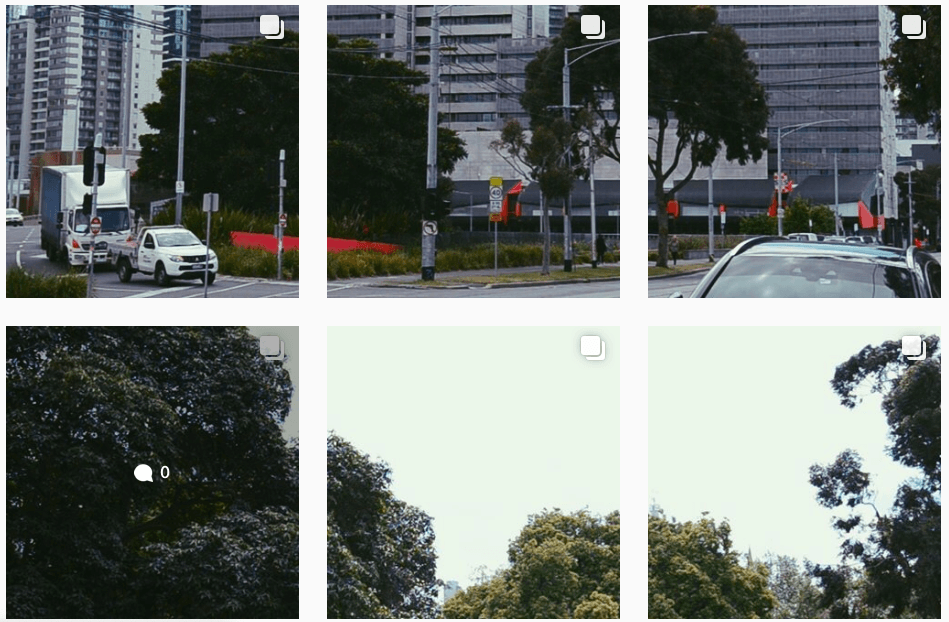Build | Grow is an Instagram account which can be viewed here (works better on mobile devices).
Alex’s reflection:
Reflecting on our project work, I feel that we have been mostly successful in responding to the prompt of “How can I notice the relationships people have with their natural and manmade surroundings?” Our intent was to create a project which invites the viewer into our moments of noticing the surroundings around us, using lingering and observing as tools for noticing. I feel that we achieved this, as actively noticing and recording our surroundings allowed us to create a media artefact that performs the complexity of the changing world around us.
Thinking back on ideas from week 10, we wanted to portray the world as something indeterminate, unpredictable and always evolving. Additionally we wanted to draw attention to both its human and non-human entanglements. Our Instagram feed allows the viewer to actively participate in noticing the relationships humans have with their surroundings by clicking on individual posts to reveal a facet of an environment. The mobile platform Instagram also allowed us to experiment with creative possibilities of making media outside of traditional linear production methods. The swipe function within a media set in particular helped us to achieve this; making graphic associations between natural and manmade surroundings prompts the viewer to think introspectively about this relationship.
Adele’s reflection:
What I have discovered about noticing and nonfiction through this assignment is mainly how exploring alternative/new media forms can open up unique opportunities in these areas. Through our academic research as well as exploration into creative media of multiple forms, we discovered that presenting our final media work as an Instagram account allowed for substantially more audience participation and involvement with our work, as they were able to scroll through and explore each image and video at their own interest and notice things uniquely. This is a benefit of many new media forms, such as websites and Korsakaw films, and I believe these forms will become even more popular in the nonfiction genre of media as technology continues to evolve. I also discovered that using a combination of noticing practises during our production- while the photography was based on initial impressions and what interested us, the videography was specifically captured to replicate it- was beneficial, as we were almost viewing my surroundings with two different perspectives at once which I feel aided our final work and understanding of noticing and nonfiction in general.
The process of noticing in relation to making audio-visual media evolved for me throughout this assignment due to the introduction of more professional technology, as this was my first project work this semester in which I used a camera as opposed to my phone. Initially I was hesitant towards doing so, as I had always favoured my phone due to the simplicity and speed it provided for capturing things I would notice, but I found through this assignment that using the camera was not as much of a hindrance as I expected, and we were still able to capture our noticing authentically. I also believe that using more high definition technology improved our final product by making the images and videos vastly clearer, which allowed for more detail to be noticed by the audience- as one constraint of Instagram is that it lowers image resolution, especially after we had to crop each image for our collage, I believe using the camera was definitely necessary in the end. As for the nonfiction aspect, although our project work was built upon a key question as well as a mission statement, I believe these did not detract from the authenticity of our work or add a particular narrative. Previously, I had assumed having a substantial amount of background research, ideas and planning would affect the identity of our work as a nonfiction project, but as our noticing practise was still spontaneous and captured authentically I have now learnt that this was not necessarily true.
Throughout the semester, I have outlined three learning outcomes for myself in my future media works, based upon our studies into noticing and nonfiction. The first is to, in future, take a more systematic approach to my noticing practise- this is mainly inspired by the Mason reading Forms of Noticing (2002), which resonated with me due to its definition of clear steps (ordinary noticing, marking and recording) and his explanation into how practising this formula can strengthen your media work as a whole. Through using these steps in my media practise this semester, particularly in Assignment Three, I have grown to greatly appreciate them and think they have improved my media making skills, in particular my ability to notice and draw inspiration from the world around me, so my learning outcome is to continue adopting and strengthening this technique in my future creative works.
My second learning outcome, inspired by the Reality Hunger reading we often revisited in class discussions, is to be less fixated on constructing a definitive narrative for my future works. Several statements in the text, such as “all the best stories are true” made me consider taking a more nonfiction, authentic approach to my practise and allowing the audience to draw their own conclusions and links based upon what they notice upon viewing, and through studying and practising this more objective approach throughout the semester I think it has broadened my understanding of media making and will be extremely helpful in future projects.
The final learning outcome I have determined, based on feedback I have received on my assignments and in class discussions, is to consider my use of technology in my media works more thoroughly, in particular equipment. Although I feel that the technology I used was mostly suited towards each assignment and its intention, I often felt restricted to just using my phone due to the convenience. In future, I would like to consider all possible options and ultimately make my decision based solely on what will strengthen my work the most.

